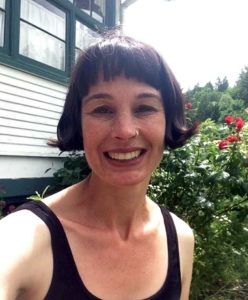265: Kateen Fitzgerald on Designing Dynamic Food Systems.
Shifting a food-growing landscape into a more natural system.
 Kateen is a tree of many branches; she’s a design consultant, mentor, teacher, farmer, gardener, and mom. After 20 years of teaching and mentoring, she decided to create something more. In 2007, she purchased 40 acres of land near Port Townsend, WA and built Compass Rose Farms, a bio-intensive family farm and homestead.
Kateen is a tree of many branches; she’s a design consultant, mentor, teacher, farmer, gardener, and mom. After 20 years of teaching and mentoring, she decided to create something more. In 2007, she purchased 40 acres of land near Port Townsend, WA and built Compass Rose Farms, a bio-intensive family farm and homestead.
Two years later she began an internship program to teach modern homesteading, holistic animal wifery, and regenerative food systems. Effectively, converting the farm into a permaculture demonstration site, she then founded The Dirt Rich School, a nonprofit education program dedicated to “Empowering people to live in abundance and thrive in a changing world.”Don’t miss an episode! Click here to sign up for weekly podcast updates
In This Podcast:
Learning about many different methods to garden, Kateen Fitzgerald kept going and learning until she found the program that put everything into place for her. Now she teaches others about permaculture, dynamic designing, and working with nature to cultivate a landscape to a beautiful and productive result. She talks about what can be gained from the many concepts of landscape design that has become her passion.
Listen in and learn about:
- Growing up with grandparents and parents that grew food and lived sustainably off the land
- Working in landscape and gardening for 28 seasons
- Becoming an organic gardener, then a Master Gardener
- Getting lost in all the different styles she had learned
- Finding the world of permaculture and ‘finding her people’
- Her definition of Permaculture
- Her initial reluctance to accept permaculture
- The moment she realized she wanted to learn more and what she did to learn
- Pursuing her teacher training in permaculture
- The Permaculture Internship – three months long of applied, hands-on learning
- The 72 hours Permaculture Design Course
- Cultivated ecosystem concept
- Working with wildlife
- Her 80/20 rule regarding weeds
- Steps for working the weeds: observe, identify, look up properties, how hard to pull
- The hit list: Grass Poisonous Sticks or stings Difficult to pull or invasive
- Dynamic accumulators and how weeds help the food web
- Tips on being a lazy farmer
- Composting, mushrooms, chop and drop, scatter mix
- Stacking functions examples, (too many to list)
- Stacking in time and space
- Obtaining dynamic abundance and huge volume of nutrient dense food from a small space
- Her most important permaculture concepts: observe and interact
- Touching on the single concept of observation
- Taking the steps to interact with the space just observed
As well as:
- Her failure – She “wants to fail faster so she can learn more”; the first time she shifted from being a gardener to a farmer, having an animal die, and feeling guilty
- Her success – Overcoming her own learning disability and teaching her children to read
- Her drive – Seeing the “a-ha” moments when people feel empowered around growing their own food
- Her advice – Never stop learning, just keep learning
Kateen’s Book recommendations:
The Resilient Gardener: Food Production and Self-Reliance in Uncertain Times by Carol Deppe
How to reach Kateen:
Website: TheDirtRichSchool.org
Email: thedirtrichschool@gmail.com
UrbanFarm.org/DirtRichSchool
Producer’s note: You can look up a Permaculture Design Course in your local area, or if you are in the Phoenix area click here for the course that the Urban Farm offers.


